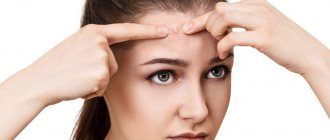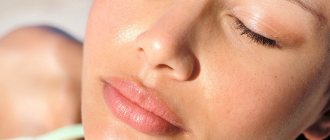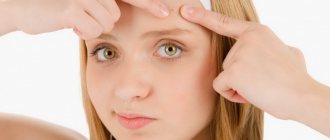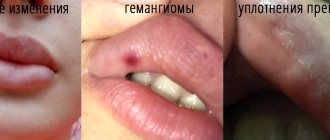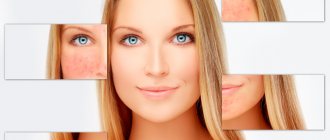Blackheads on the face are a problem for most people with oily skin. These are comedones - open pores filled with excess sebum. Dust and exfoliated cells give the top of the sebaceous plug a dark color. There are different ways to cleanse the skin of this unpleasant phenomenon, but the most common options are mechanical and ultrasonic.
- Find out the current offers
- Sign up for a consultation
Online registration
Photos before and after removing blackheads on face
Cleaning ears with wax plugs
People most often come to an otolaryngologist with complaints about earwax. In this case, patients experience hearing impairment, the cause of which is clogging of the ear canal with sulfur. The substance contains a lubricating secretion of glands and keratinized epithelial particles.
Often, a noticeable decrease in the ability to perceive sounds is observed after taking water procedures, swimming, when water gets into the ears. The cause of aching or sharp “shooting” pain is swelling of the conglomerate. If you have pain symptoms, you should contact a medical facility as soon as possible; you should not try to clear wax from your ears on your own, as this can lead to the development of complications.
Mechanical acne removal
It is unlikely that you will be able to squeeze out acne in your ears with your hands.
Black fat dots can be removed this way:
- Steam the skin of the ears and around the auricle by applying a cotton pad dipped in hot water.
- Disinfect hands and tools with alcohol.
- Also wipe the problem area with medical alcohol, massaging the area with blackheads.
- Press on the blackheads with a special tool, then the steamed comedones will quickly come out.
- Apply alcohol to the problem area.
To prevent acne from appearing again, lubricate the treated area with tea tree oil. Its antibacterial properties will help destroy dangerous microorganisms and speed up healing. The oil is too concentrated, so it is diluted with water 1:9.
Ear plugs: main causes
The ears have a complex structure; the sulfur glands perform a protective function. The external auditory canal connects the eardrum to the outside world and is a curved, hollow tube. The outer part of the passage has a membranous-cartilaginous structure, the inner part has a bone structure. The outer part contains sulfur glands.
The number of sulfur glands can reach two thousand. Harmful microorganisms and dust particles stick to the secretion they produce. This is how the protection system works, preventing infectious agents and debris from entering the deep places of the ear canal. The skin of the ear canal regenerates very quickly, and epithelial cells divide in an outward direction. There is a constant production of sulfur; up to 20 mg of secretion can be formed per day. This mass gradually moves towards the entrance along with added contaminants. This process is usually invisible to a healthy person. Daily cleaning of the vestibule of the ear canal and wiping the outer part with water ensures comfortable cleaning of accumulated wax.
What is the reason for the accumulation of secretion in the ear? Ear wax can form due to improper cleaning or neglect of personal hygiene rules.
Often people use a cotton swab to push the sulfur into the bone region, trying to immerse it as deeply as possible. Such manipulations damage the skin of the ear canal, which causes increased secretion production. This mass is formed in large quantities and does not have time to come out on its own, it is compressed. Diseases of the digestive system and metabolic disorders can also create a violation of the consistency of the sulfur glands or increased secretion.
Some factors can cause hearing loss:
- genetic predisposition (increased viscosity of gland secretions, excessive hair growth, and some structural features of the canal are often inherited);
- staying in areas where there are sharp changes in atmospheric pressure (swimming at great depths, hiking in the mountains);
- frequent inflammatory processes in the nasopharynx during ARVI (enlarged adenoids in children with a chronic inflammatory process can cause ear plugs);
- the use of in-ear headphones and other sound amplifiers (long telephone conversations cause increased release of conglomerate);
- various skin diseases (the outflow of sulfur can be complicated due to psoriasis, dermatitis; inflammatory processes of the skin affect the cartilaginous part of the canal).
Poor nutrition can also cause increased secretion production. The presence of a high concentration of cholesterol in the blood makes sulfur viscous and accelerates hair growth.
Ear cysts
Earlobe cysts - sebaceous cysts
Some patients report that they find a bulbous appearance on their earlobe or behind their ear (a pimple inside the earlobe). The doctor can determine whether this lump is a lymph node of inflammatory etiology (various scalp infections, pharyngitis, otitis media, etc.), lipomas localized behind the ear, parotid tumor, etc.
But the most common diagnosis is atheroma or epidermal cyst in the ear area.
The patient, using his fingers, feels in the area of the lobe a round, small and hard lump that appears in the ear area or behind the ear. Although the word "epidermal cyst" may seem a little scary, lobular cysts are not considered dangerous.
An epidermal cyst is actually a type of sebaceous blister and is a sac formed in the subcutaneous layer (subcutaneous cyst) by the sebaceous glands. It can be a small, medium or large epidermal cyst.
Causes of cyst formation in the earlobe
It is not entirely clear what exactly causes ear cysts. One explanation is that cysts are caused by overproduction of sebum by the sebaceous glands of the skin. These glands, located under the skin, produce a certain substance called sebum, which lubricates the dermis. The sebaceous glands continue to produce sebum, which eventually accumulates locally, forming a so-called sebaceous blister.
Other possible causes of earlobe cysts include skin trauma, infection, or inflammation of the hair follicles.
Treatment of earlobe cyst
Often cysts behind the ear are asymptomatic, but if there is damage to the skin, infection can occur. In this case, in addition to the usual compaction, the person feels significant discomfort, pain, and the affected area becomes hyperemic and swollen. The solution to the problem in this case is radical - the cyst is removed to prevent the occurrence of any complications.
In a contaminated sebaceous bladder, removal of such a cyst is not always safe, so first the surgeon makes a single hole for drainage, while the cavity is treated with antibacterial agents. The mentioned alarming symptoms become an external reason for carrying out such manipulations.
Please note that a sebaceous bladder cannot degenerate into a malignant tumor. At a late stage (after approximately 15-20 days), in the absence of complications, standard surgical excision is performed.
Contraindications for sebaceous cyst removal:
- cyst obstruction with abscess formation;
- critical increase in cyst size;
- aesthetic reasons (in the absence of complications).
Sebaceous cysts on the ear - removal features
The surgical procedure is simple and is usually performed in a clinic or hospital.
Duration of surgical removal of a cyst in the ear: about 10-20 minutes.
Removal of the cyst should be carried out radically with an intact, intact capsule, so that the sebaceous bubble does not return again in the future. Removal of a cyst inside or behind the ear is carried out under local anesthesia or general anesthesia. An incision is made in the center of the cyst, the cyst is discovered, after which it is excised.
After the cyst is removed, the area is cleaned and disinfected. For a better aesthetic result, a cosmetic suture is made. Antibiotics are prescribed to prevent possible infections. The sutures are removed after 7-10 days.
Signs of ear plug formation
Sulfur plugs often form completely unnoticeably. When pain or uncharacteristic sound effects appear, many suspect otitis media, although such pathological symptoms often indicate the formation of sulfur accumulation.
Most often, sulfur plugs make themselves felt after swimming. The development of pathological processes can be suspected by the following symptoms:
- pain, itching;
- unusual noise, crackling;
- feeling of fullness;
- you can hear your own echo in your head;
- discomfort when chewing food;
- distortion of sounds or hearing loss.
Situations where cerumen plug has formed next to the eardrum are the most dangerous. The patient may experience weakness, cough, dizziness and nausea, but there are no typical symptoms of colds.
It is necessary to visit an otolaryngologist as soon as possible. You should not use folk remedies or try to solve the problem yourself. Inadequate treatment can negatively affect your health. It is important to carry out therapy correctly and in a timely manner.
Medical offers to make an appointment with an otolaryngologist (ENT) of the highest category. A full range of diagnostics and treatment of ENT diseases in Tula. Tel. for recording.
Acne is inflamed and painful, what should I do?
If an inflamed acne hurts, you can apply a cotton swab dipped in aloe juice and hold for 25 minutes. Perform this manipulation until healing.
An apple cider vinegar compress will also quickly help cope with this skin disease.
Tea tree oil and all antiseptic preparations will definitely help cope with the problem.
But squeezing out an inflamed comedone is not recommended. You can cause an infection and delay healing.
Methods for removing an ear plug
You need to know that you can safely get rid of a “clog” in your ear only in a medical facility. The specialist will examine the ear canal, study the patient’s complaints and be able to make a diagnosis. When examining an organ, doctors use a light source (flashlight) and a special funnel.
To remove earwax and get rid of congestion, doctors in modern clinics use two methods:
- “Wet” is a common technique in which a syringe or a nozzle from an ENT combine is inserted into the ear canal, into which liquid is supplied under pressure. The conglomerate is washed out.
- “Dry” - the doctor works with a tiny hook, grabbing and pulling out lumps in parts. The procedure is carried out without wetting the canal. It is necessary to constantly monitor the process, act with extreme caution and have high qualifications. Any sudden movement can damage the eardrum.
How to remove acne in the ear: traditional medicine
There are a lot of good traditional medicine remedies that help quickly and painlessly remove comedones in the ears. The simplest and most accessible remedy is hydrogen peroxide. It helps remove blackheads that are deep in the ear.
If the points are located within easy reach, then simply apply a cotton wool pre-moistened with peroxide to them. If it is located deep, then the liquid is simply instilled into the ear canal. Afterwards, you need to arm yourself with a cotton swab and clean the ear canal. You can simply lie on the instilled ear, allowing the peroxide to completely come out, and disinfecting the comedones along the way.
How to remove a blackhead in the ear using soda ? This is another wonderful folk recipe. It will take 1 tbsp. water dissolve ½ tbsp. l. soda The warm solution is simply dropped into the ear. There is another good recipe: just add ½ tbsp to the soda solution. l salt and 2-3 drops of iodine. Soak a cotton swab in the resulting liquid and apply to the problem area for a quarter of an hour.
You can also remove comedones in the ear using a tea bag. Immerse the bag in hot water, then squeeze it out, apply it to the clogged pore and cover with a handkerchief. Warm tea contains a substance - theine, which helps reduce inflammation, helping to treat acne.
How to remove blackheads from ears using improvised means? You can use milk. It contains substances that help remove dead cells and promotes high-quality pore cleaning. The swab should be moistened in milk and inserted into the ear opening, leaving it for a quarter of an hour, and then rinsing with warm water, repeating the procedure up to 4 times a day, you can notice significant results.
Mechanical technique
You won't be able to squeeze out a pimple in the ear with your hands. The only way to remove them is this:
- the skin around the auricle should be steamed well;
- To do this, simply moisten a cotton pad in hot water and apply it to your ear;
- treat hands and tools with a disinfectant;
- also treat the area with the problem with a disinfectant;
- using a special tool, press on the blackhead, after which they will come out;
- Treat the cleaned pore with alcohol.
To prevent the problem from recurring in this area, you should treat it with tea tree oil. It has antibacterial properties, so it not only kills pathogens, but also speeds up the healing process. Before use, the oil is first diluted with water in a ratio of 1:9.
If comedones become inflamed: what to do?
Very often, the blackhead becomes inflamed and begins to cause pain and discomfort. To remove inflammation, you can apply aloe juice to the comedone and leave it for 20-25 minutes. This method is used until complete healing.
An apple cider vinegar compress will help quickly deal with an inflamed blackhead. But you should not squeeze out inflamed comedones, as you can easily introduce an infection inside, and healing will not occur soon.
Allowed self-medication
The pathological condition of the ear canal causes discomfort in the patient, so many try to be treated at home. Incorrect treatment will not help get rid of the problem, but can cause additional negative effects. When using cotton swabs, toothpicks, matches and other long thin objects, serious complications can develop. The secretion of the sulfur glands does not come out, but is pushed even deeper. As a result, the problem worsens and unpleasant symptoms intensify.
If there is no fever or pain, you can try to get rid of the plug without visiting the hospital. To dissolve it, medicinal drops and pharmaceutical solutions are used. “A-Cerumen” or “Remo-vax”, 3% hydrogen peroxide are popular remedies that can help in this situation. They should be used strictly according to the instructions. Pharmacists can offer herbal suppositories or herbal funnels, however, these drugs can aggravate the process and their use is not recommended.
Atheroma or cyst of the sebaceous gland in the postauricular area
Atheroma is a cyst filled with dead skin cells and sebum.
Behind the ears there are countless sebaceous glands, so it is in this area that atheromas are found very often. However, atheromas can often be found in the ear canal itself.
Rice. 2. Suppurating atheroma behind the ear
Although atheromas do not become malignant (such cases are described extremely rarely), they can become complicated. First of all, atheroma, in the absence of timely treatment, can become infected. When infected, the atheroma becomes inflamed.
If the atheroma is located in the genital area, then when it becomes inflamed, pain may occur during urination and sexual intercourse.
Prevention
Carrying out regular preventative measures will minimize the likelihood of wax plugs. It is necessary to keep the ear canals clean and regularly remove secretions. Cotton swabs should not be used. Such household items can compact wax and clog the ear canal, damage the upper layers of the epidermis and cause inflammation.
Cosmetic cotton swabs are most often used after water procedures: washing hair, washing in the shower, taking a bath. A cotton swab is not able to dry the ears, but warm boric alcohol accelerates the evaporation of water. It is enough to drop 4-5 drops of the product into each passage, then lower your head and dry your ears with a towel, napkin or cotton sponge, wrapping the material around your little finger.
A cosmetic cotton swab can be used for delicate cleaning; you can wipe only the outer part of the ear canal, without going deeper than 4 mm. The vestibule should be cleaned using gentle circular movements.
If you suspect an ear plug, the right decision would be to visit the hospital. Specialists from the Diamed medical institution will perform an otoscopy, assess the condition of the canal, and, if necessary, remove the ear plug. Such procedures are safe, performed in a comfortable environment, and do not cause complications.
Ways to get rid of comedones
Many people do not even notice that they have such problems in their ears. Acne in these places does not make itself felt for the time being until it becomes inflamed. Once inflamed, they become painful, preventing you from touching your ears. This is where a person begins to wonder, what to do with these ugly rashes?
There are many medications and medical treatments that only a doctor can prescribe. A dermatologist or cosmetologist can pop out all the pimples using special tools.
The doctor may also prescribe the following medications:
- Differin fights inflammation by exfoliating the top layer of the dermis.
- Skinoren reduces the level of lipids and acids in subcutaneous fat, reducing its viscosity.
- Retinol perfectly dilutes the secretions of the glands, clearing the plugs.
- Ichthyol ointment cleanses the skin even of those plugs that lie deep in the layers of the epidermis.
- Salicylic acid promotes the release of sebum, thereby helping to get rid of blackheads.
- The antibacterial agent Zenerit cleanses the skin of acne well.

